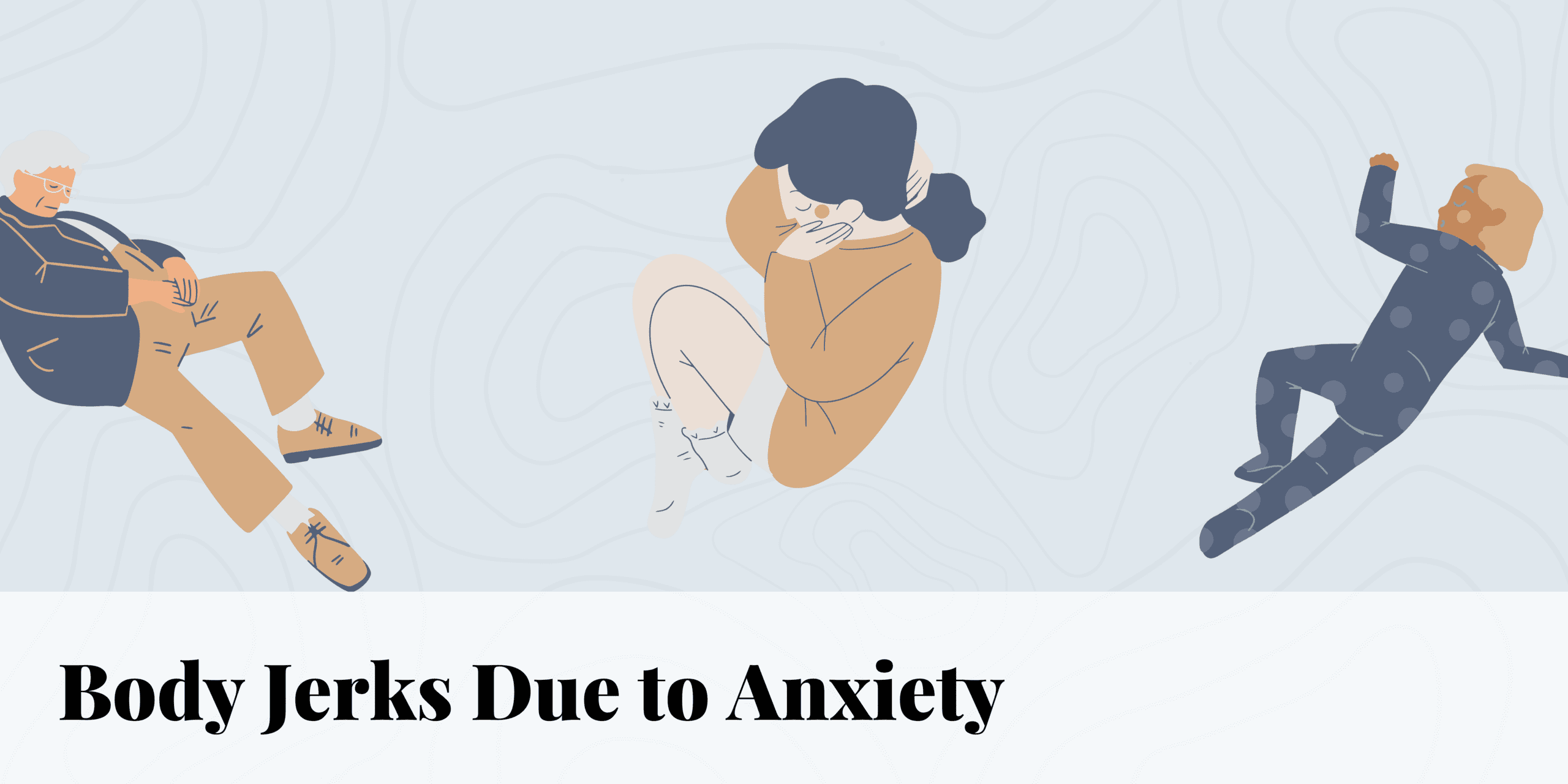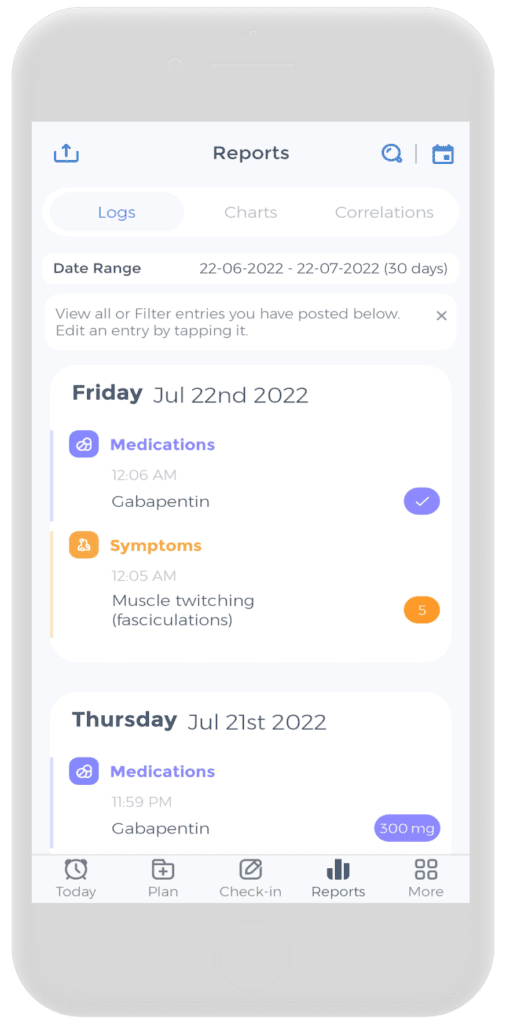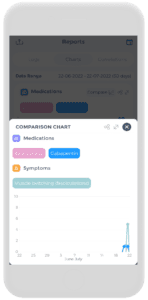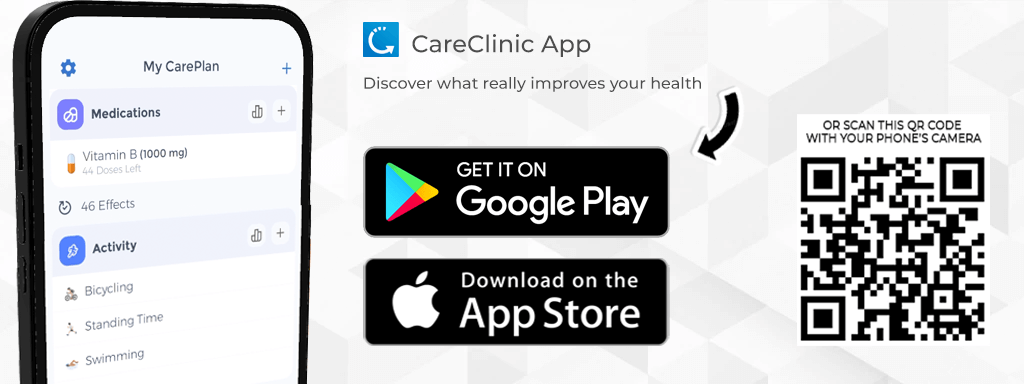
Imagine sitting at your desk, vigorously writing out a rough essay draft for your boss that’s due tomorrow. You completely forgot your deadline! You’re pretty stressed and anxious. Suddenly, your hand begins to tense and contract, jerking to the right while you’re writing. This movement is a result of your muscles twitching. Muscle twitching is associated with many disorders, including multiple sclerosis, traumatic brain injuries, and organ failure. However, what is less commonly recognized are body jerks due to anxiety.
In many cases, anxiety and muscle spasms appear hand in hand. However, this symptom is often one of the first that comes to mind when discussing anxiety. In fact, as of 1992, twitching, while a popular symptom of the disorder, was not previously recognized as a symptom of anxiety 1. It was due to a study conducted in 1993 that nervous twitching was shown to be positively correlated (at +0.24) with manifest anxiety1. Today, we know much more surrounding body jerks due to anxiety. Learning how to recognize this sign may help you take control of your anxiety by receiving proper medication and/or developing appropriate coping mechanisms.
What are Body Twitches and Muscle Jerks?
Muscle Twitching
Muscle twitching, also known as myoclonus, or visible twitches in individual muscles – fasciculations – are defined as involuntary muscle movements 2. In fact, you and I both have probably experienced these movements many times in our life, especially as young children. Any guesses as to what this may be referring to? Hiccups! Hiccups are a mild form of myoclonus, along with jumping with fear or that sudden jerk that many of us experience while falling asleep. Contrarily, more severe muscle twitching is much more common in neurological diseases, including epilepsy and Parkinson’s disease2.
Neck Twitching
Muscle twitching, including neck twitching and facial spasms, generally comes on unexpectedly and suddenly2. During a twitch, your muscle will either contract or relax and are known as positive and negative myoclonus respectively. These unexpected and uncontrollable movements are often accompanied by a sharp throbbing pain. Moreover, they can be slow, spaced apart, repetitive or involve tremors3. Spasms can be experienced anywhere in the body, such as the arm, leg, abdomen, hand or face, and may affect one side, both sides, or different muscles at the same time2,3. The take-home message: these jerks are varied with many different possibilities.
Types of Body Jerks due to Anxiety
Body jerks are usually classified into one of 6 types:
- Action – Planning, thinking about moving or actually moving can cause muscle spasms. This is the most disabling type and can affect the face, arms and legs2.
- Epileptic – Epilepsy can make you more prone to muscle twitches2.
- Essential – These twitches appear with an unknown cause and generally progress slowly2.
- Sleep – Twitches sometimes occur while you’re sleeping and may be a sign of restless leg syndrome2.
- Stimulus-sensitive – Lights, noise or activity, can trigger muscle spasms2.
- Symptomatic – Also known as secondary muscle twitches, these muscle twitches occur due to an underlying medical cause, including ataxia or Parkinson’s disease2.
The majority of patient cases presenting with muscle twitches are symptomatic and secondary to underlying medical causes4. In addition to the diseases we’ve already mentioned – Parkinson’s ataxia and multiple sclerosis – some common clinical associations made in regard to secondary myoclonus include movement disorders (dystonia, Huntington’s disease, multiple system atrophy and many more), seizures, Lewy Body disorders such as dementia and drug-induced4.
Panic Attack Muscle Spasms

Drug-induced body jerks are one subtype that has grown significantly over the years4. As these muscle twitches are due to the consumption of a certain drug, withdrawal of the drug makes them 100% treatable. As an example, lithium prescribed at therapeutic levels shows isolated cortical myoclonus in the motor cortex. Additionally, Quinolone antibiotics can cause myoclonus in either the presence or absence of seizures. Accordingly, Gabapentin and pregabalin – antiseizure medication – have also shown an association with muscle spasms. And yet, the list doesn’t end here. Many types of medication, ranging from psychiatric to anesthetics to cardiac medication, are associated with involuntary body movement4.
This is why it is essential that you record and carefully keep track of all medications you may be taking. Now, this may be daunting, trying to remember exactly when your body jerks started and when you began any of your medications to determine if there is any relation. It’s quite a big ask for anyone to do! The CareClinic app makes this task simple with the medications and symptoms feature. Both are easy to find on the check-in page of the app. View your past and present check-in posts easily under your reports to see which symptoms started when and with which factors. Overall, CareClinic makes tracking your health progression effortless and uncomplicated!
Anxiety and Muscle Spasms
One of the leading causes of involuntary body and muscle movements: is mental status abnormalities4. This is a broad label including almost any psychiatric/psychological disorder in the book, from obsessive-compulsive disorder to schizophrenia. The one we will be focusing on today is most well-known as anxiety or generalized anxiety disorder (GAD).
Anxiety is a chronic and highly prevalent disorder among the adult population5. In fact, anxiety is the most common mental disorder, with approximately 30% of adults experiencing it at some point in their lives. Anxiety was a poorly understood condition for quite a while, with most research and knowledge only being discovered in the past two decades5. Medication and therapy are the most common forms of treatment, but there are many ways to manage anxiety without medication.
Lifestyle changes, such as exercise and relaxation techniques, can be very effective in managing anxiety. Some people may also find that supplements or natural remedies help to relieve their symptoms. Anxiety is a condition that affects everyone differently, so it is important to find what works best for you.
Anxiety Symptoms
Some common defining symptoms include:
- Excessive worry or restlessness5,6
- Hypervigilance5,6
- Being easy fatigued6
- Difficulty concentrating6
- Headaches, muscle aches, stomach aches or pains6
- Uncontrollable feelings of doom6
Types of Anxiety
Anxiety is a relative term for a persistent feeling of anxiety or dread. The disorder can be further broken down into specific types of disorders.
Social Anxiety Disorder
Individuals with social anxiety constantly feel fear or judgment from others6. For these people, social situations feel so intense that they appear beyond their control and may inhibit them from going about their daily lives. Key features of social anxiety include a racing heart, difficulty making eye contact and a rigid body posture with a soft voice6.
Panic Attacks
People with panic disorder experience frequent panic attacks6. These are attacks of fear, loss of control, and stress even with a lack of triggers. While all individuals with this disorder will experience panic attacks, a panic attack does not necessarily mean you have the disorder. These attacks may occur daily or a few times a year. Key features include sweating, trembling tingling, and chest pain6.
Phobia-Related Disorders
Individuals with a phobia – and intense fear or aversion – may experience widely out-of-proportion anxiety in the face of whatever they fear about the actual danger caused by the situation or object6. Some telling features of this disorder include taking active steps to avoid the feared object or situation and having an irrational worry about encountering it6. Graded exposure therapy is often used to overcome this disorder.
Can Anxiety Cause Muscle Spasms?
The short answer is yes. Anxiety has been recorded on countless occasions with uncontrollable movements. For example, maybe you’re eye twitches when you’re speaking in front of a class, or your knee jerks when you’re in the waiting room for an appointment. Whatever the movement may be when in a high-stress, anxiety-triggering situations, body-twitching anxiety or panic attack, anxiety muscle spasms are possible.
Random Body Twitching Anxiety
One theory states that anxiety induces stress hormones that travel through your body and cause involuntary movements3. This happens because your body reacts to the stress by triggering your fight, flight, or freeze response. The physiological changes that occur as your body enters this response include an increase in blood sugar, pressure, or electrical activity in the nervous system. As a result, muscles can tighten3. Additionally, anxiety-induced hyperventilation can change ion concentrations and pH in the body, predisposing you to muscle twitching7. All in all, these symptoms alone or together can cause the manifestation of body twitching anxiety or what feels like body jolts anxiety3. This could be neck twitching, facial spasms, anxiety, panic attack muscle spasms, or just general anxiety and muscle spasms3.
The second school of thought essentially states that we’re extra cautious. When we experience frequent stressors, our body becomes prone to keeping that wall up, causing our muscles to keep moving even during rest, as a precaution3. This is known as incomplete stress recovery – when you respond to stressors, even if not present3.
Body Jolts Anxiety
Sleep deprivation causes excess cortisol – a stress hormone – production. This, in turn, increases the likelihood of muscle twitching3.
Nutritional deficiencies in, for example, calcium and magnesium, can induce anxiety and affect your nervous system and motor movement3.
Dehydration caused by high anxiety can result in your body’s inability to efficiently transport nutrients to the muscles3.
Hormonal changes may be interpreted as stress by your brain and result in involuntary twitching or jerks3.
Low blood sugar caused by anxiety-induced malnutrition can cause energy depletion in your muscles, aggravating jerks and spasms3.

Monitoring these factors can be daunting, especially when determining which corresponds to muscle twitches you may be experiencing. To figure this out, you would have to overlap the symptoms with these anxiety-induced factors to be able to see the full picture of your health. Fortunately, CareClinic has a built-in compare feature under the report’s chart that makes visually viewing these relationships straightforward!
For example, imagine you have just begun taking birth control and anti-seizure medication gabapentin. You later begin to experience unexplained anxiety and muscle jerks experiencing in your wrist. When you pull out the CareClinic app to compare your medications to symptoms, you notice the two overlap, and both begin on the same day. Resultantly, you speak to your doctor and agree that hormonal changes are likely making you experience high stress and enhancing gabapentin-induced fasciculations.
It’s clear to see that CareClinic makes getting to the root of the problem unchallenging and uncomplicated! Recognizing patterns and correlations through these charts helps you modify your habits always to feel your best!
Stopping Body Jerking Due to Anxiety
After reading all this, there’s only one question: How to stop body twitches? Implementing healthy living habits into your daily routine can prevent body twitching anxiety. These habits can help you stay nutritionally balanced, keep your muscles healthy and strong, and help your anxiety stay under control.
- Eat Healthily – getting a good mix of fruits, vegetables, greens, and protein replenishes your body to prevent nutritional deficiencies7.
- Get enough sleep – sleep is essentially a recharge for your body’s battery, helping to keep it going without a hitch7
- Drink water – Keeping track of your water intake will help you stay ahead of dehydration that can lead to facial spasms, anxiety or neck twitching7.
- Exercise daily – I know everyone says to exercise for the prevention or every illness, but that’s because it does work! 30 to 45 minutes of daily exercise maintains muscle tone and prevents twitching7.
- Seek therapy – individuals with anxiety experience marked improvement after attending therapy, specifically cognitive behavioral therapy (CBT). Your therapist can help you manage and treat your stress for the long term3.
While these methods tackle how to stop manifested body jolt anxiety, they do not address how to stop anxiety-induced or panic attack muscle spasms. To do this, you may instead need to consider medications.
Taking Medication for Body Jerking
Just like with CBT, medication targets the root of the problem – anxiety – to treat the symptom. Prescribing either antidepressants or anti-anxiety medications commonly achieves this purpose.
Benzodiazepines
Benzodiazepines are anti-anxiety medications that eradicate symptoms of worry, fear and panic attacks8. There is a go-to choice for physicians due to their low toxicity. However, it is important o keep usage in moderation, as these rugs can be highly addictive. They are generally only used for the short term and induce muscle relaxation in the individual taking them. This makes them especially beneficial regarding manifested body jolt anxiety8.
There are many different kinds of benzodiazepines readily available on the market, quite a few of which I am almost sure you have heard of before. Diazepam (Valium), alprazolam (Xanax) and clonazepam (Kronospan) are 3 of the most well-known anti-anxiety benzodiazepines8.
Selective Serotonin Reuptake Inhibitors (SSRIs)
These medications are generally classified as antidepressants and work to increase the amount of serotonin in your brain9. This makes you generally feel happier, less worried, more relaxed and generally better, thus eliminating anxiety symptoms. However, SSRIs also come with their own list of side effects you should consider, such as headaches, dry mouth, drowsiness, and weight gain.
Some examples of SSRIs include Paxil (paroxetine), Prozac (fluoxetine), Zoloft (sertraline) and Lexapro (escitalopram) 9.
Serotonin-Norepinephrine Reuptake Inhibitors (SNRIs)
Think of these medications like SSRIs – with the same side effects and all – but with double the target, elevating levels of both serotonin and norepinephrine9. This boosts your mood and makes you feel more relaxed when suffering from an anxiety disorder. Examples of SNRIs include Effexor (venlafaxine), Cymbalta (duloxetine), and Pristiq (desvenlafaxine)9.
Identifying the Cause of Muscle Spasms

Feeling like you’re losing control is often a sign and symptom of anxiety. For many of us, that feeling isn’t pleasant at all and can lead to helplessness, additional stress, and a loss of self-identity. It is, of course, important to remember that feeling some level of anxiety is a normal reaction and can be beneficial5. For example, anxiety can help you react quickly and pay attention to details you may normally miss in high-pressure, dangerous situations. However, in individuals suffering from anxiety disorders, anxiety can be a real hindrance to your day-to-day life. Body jerks due to anxiety can make this even more frustrating.
Perhaps you begin to experience muscle twitches but can’t identify whether the cause is anxiety or otherwise. Luckily, the CareClinic app conveniently offers a GAD-7 Anxiety screen test. This test, found under scales and questionnaires in the ‘More’ section of the app, scores your anxiety based on a series of questions. From there, diagnosis and determining the root cause of muscle twitching becomes simple!
Moreover, while CBT and medication can help you manage your anxiety, monitoring your progress is essential to continue improving. Your mental and physical health can take a turn at any moment. Recording what steps you are taking in your health journey can help determine what works and doesn’t.
Maybe you benefit more from anti-anxiety medication as compared to antidepressants. Maybe therapy on its own offers you more relief than anything. The therapy and medication trackers available on the check-in page of the CareClinic app allow you to record your treatment, helping you deduce what works best for YOU.
Regardless of the scenario, CareClinic can help you keep in touch with your progress and improvements. CareClinic is dedicated to keeping you in control and ahead of your anxiety, physical symptoms, and all your general health concerns, giving you the tools you need to help you be the best version of yourself, you can be.
References
- Joubert, C. E. (1993). Relationship of Self-Esteem, Manifest Anxiety, and Obsessive-Compulsiveness to Personal Habits. Psychological Reports, 73(2), 579-583. https://doi.org/10.2466/pr0.1993.73.2.579
- Cleveland Clinic. (2020, September 28). Myoclonus (Muscle Twitch). Retrieved from: https://my.clevelandclinic.org/health/symptoms/15301-myoclonus-muscle-twitch
- Nelson, L. (2020, March 3). How To Manage Muscle Twitches Caused By Anxiety. Retrieved from: https://healthmatch.io/anxiety/muscle-twitches
- Caviness, J. N., & Brown, P. (2004). Myoclonus: current concepts and recent advances. The Lancet Neurology, 3(10), 598-607. https://doi.org/10.1016/S1474-4422(04)00880-4
- Wittchen, H-U., & Hoyer, J. (2001). Generalized Anxiety Disorder: Nature and Course. Journal of Clinical Psychiatry, 62(11), 15-19. https://www.psychiatrist.com/read-pdf/7719/
- National Institute of Mental Health. (2022). Anxiety Disorders. Health Topics. Retrieved from: https://www.nimh.nih.gov/health/topics/anxiety-disorders
- Rajneesh, K. (2019, March 14). Why do my muscles twitch?. Wexner Medical Center. Retrieved from: https://wexnermedical.osu.edu/blog/muscle-twitching
- O’Brien, C. P. (2005). Benzodiazepine Use, Abuse, and Dependence. Journal of Clinical Psychiatry, 66(2), 28-33. https://www.psychiatrist.com/read-pdf/29532/
- Holmes, L. (2021, July 18). Medications and Treatment Approaches for Management of Anxiety. Retrieved from: verywellmind.com/anti-anxiety-medications-2330663


